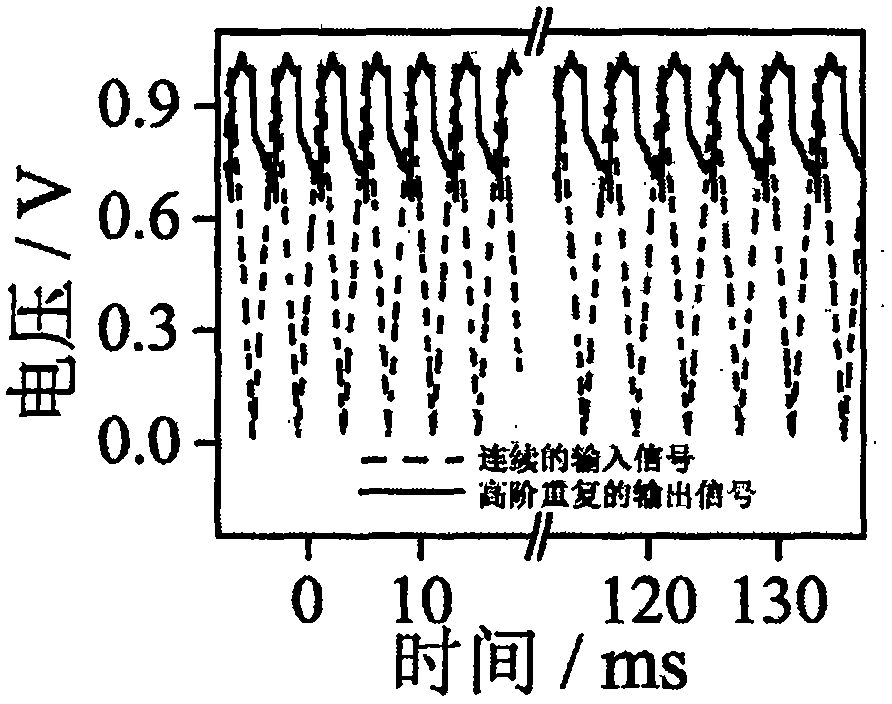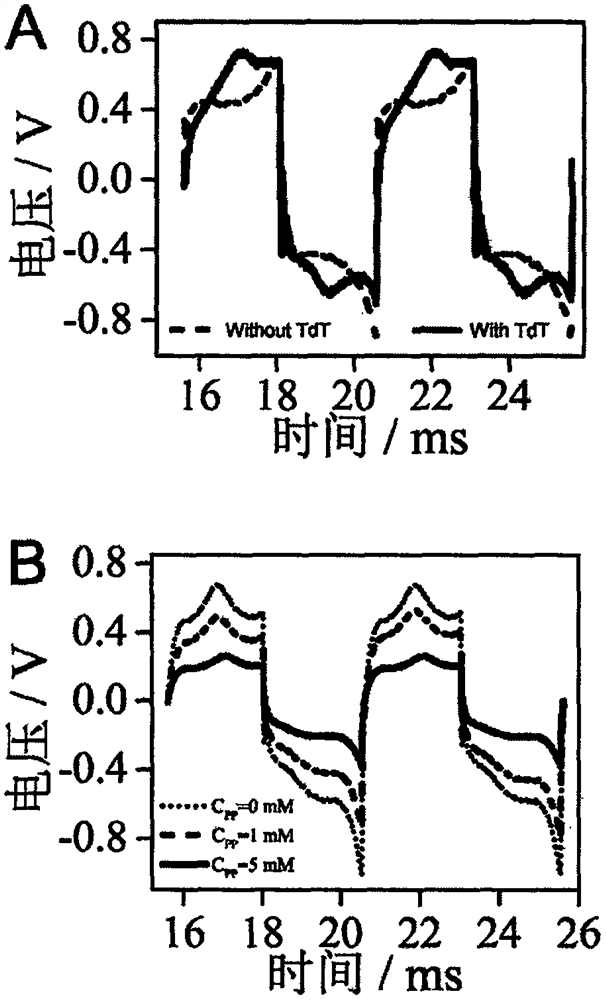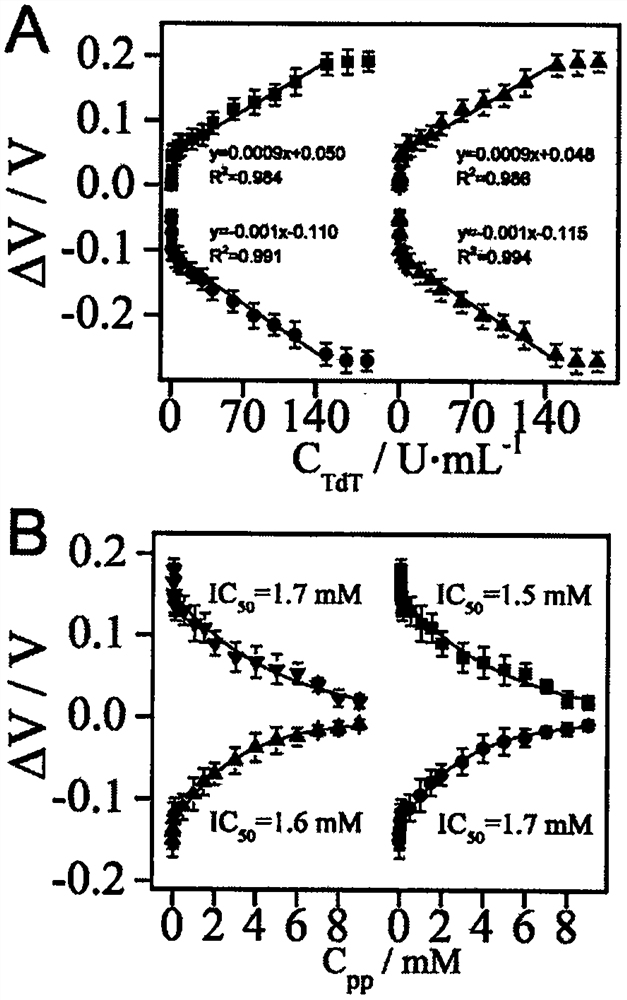Electrochemical fast sweep voltammetry method with high-order repeatability and reproducibility and analysis application of electrochemical fast sweep voltammetry method
An analysis application and repeatability technology, which is applied in the field of electrochemical analysis technology and biosensing, can solve the problems of poor repeatability and reproducibility, cumbersome material synthesis, complex chemical reactions, etc., and achieve high reproducibility and short analysis time , the effect of high scan rate
- Summary
- Abstract
- Description
- Claims
- Application Information
AI Technical Summary
Problems solved by technology
Method used
Image
Examples
Embodiment 1
[0032] The preparation of embodiment 1 electrochemical biosensor comprises the following steps:
[0033] Bare electrode: use 1μm, 0.3μm, 0.05μm Al on the gold electrode with a diameter of 2mm 2 o 3 The powder was polished to a mirror surface, then ultrasonically washed with water and absolute ethanol for 5 min, and dried with nitrogen, the gold electrode was placed in 0.5M H 2 SO 4 The solution was scanned by cyclic voltammetry (CV) until the signal was stable. Finally, dry it again with nitrogen gas for later use.
[0034] Electrode 1: Add 5 μL of thiol DNA with a concentration of 10 μM dropwise onto the surface of the treated gold electrode, and place it in a refrigerator at 4°C overnight. After the incubation, gently rinse the surface of the electrode to remove unbound thiol DNA, and then immerse the electrode in 2-mercaptoethanol (MCH) at a concentration of 2 mM for 1 h to block the active sites that are not bound to thiol DNA .
[0035] Electrode 2: Prepare TdT reac...
Embodiment 2
[0037] Embodiment 2 feasibility analysis comprises the following steps:
[0038] According to the preparation steps of the electrochemical biosensor in Example 1 above, the TdT mixed reaction solution added dropwise to electrode 2 includes 0.2 μL of TdT solution with a concentration of 0 and 100 U / mL, 1 μL of a dTTP solution with a concentration of 10 mM, and 2 μL of 5×TdTbuffer and 2 μL of double distilled water. Other steps and experimental conditions are the same as the electrode preparation steps, and are used for the feasibility detection of the invention.
[0039] Using FSCV detection, the prepared electrode 3 is used as the working electrode, the platinum electrode is used as the counter electrode, and the Ag / AgCl electrode is used as the reference electrode, and placed in the PBS electrolyte solution of pH=7, the initial potential is set to 0V, and the termination potential is 1V. The scanning speed was set to 400V / s. The result is as figure 1 (C TdT =100U / mL), the...
Embodiment 3
[0043] Embodiment 3 TdT enzyme activity and the detection of inhibitor
[0044] According to the preparation steps of the above-mentioned Example 1 and the electrochemical response of different TdT / PP in Example 2, by changing the final concentration of TdT (0.1-190U / mL) or PP (0-9mM) in the mixed reaction solution, using FSCV To test the sensor, set the initial potential to 0V, the end potential to 1V, and the scan speed to 400V / s. like image 3 A. The voltage response of the sensor to TdT has a good linear relationship with the concentration. The linear correlation equation between the voltage response of the sensor and the concentration of TdT is ①y=0.0009x+0.050, R 2 =0.984, ②y=-0.001x-0.110, R 2 =0.991, ③y=0.0009x+0.048, R 2 =0.986 and ④y=-0.001x-0.115, R 2 = 0.994. The linear equations of the two selected periodic data are similar. Within the allowable range of error, the detection linear range is 0.5-150U / mL, and the detection limits are ①0.067U / mL, ②0.1U / mL, ③0.06...
PUM
 Login to View More
Login to View More Abstract
Description
Claims
Application Information
 Login to View More
Login to View More - R&D
- Intellectual Property
- Life Sciences
- Materials
- Tech Scout
- Unparalleled Data Quality
- Higher Quality Content
- 60% Fewer Hallucinations
Browse by: Latest US Patents, China's latest patents, Technical Efficacy Thesaurus, Application Domain, Technology Topic, Popular Technical Reports.
© 2025 PatSnap. All rights reserved.Legal|Privacy policy|Modern Slavery Act Transparency Statement|Sitemap|About US| Contact US: help@patsnap.com



